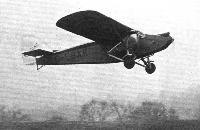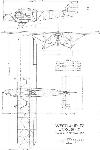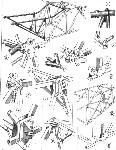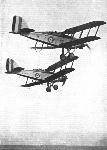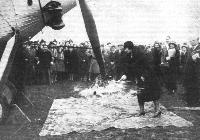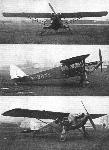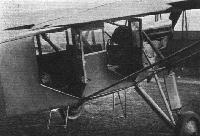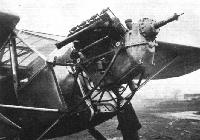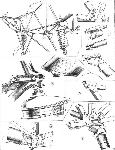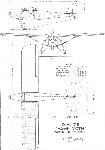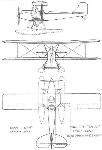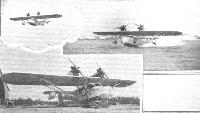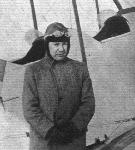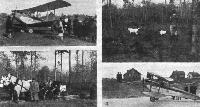Фотографии
-
Регистрационный номер: D-170, D-2000, D-AZUR THE NEW JUNKERS MONOPLANE: This photograph shows two scale models, the J.38 on the right and the W.33 on the left for purposes of comparison.
Самолёты на фотографии: Junkers F 13 - Германия - 1919Junkers G 38 - Германия - 1929
-
Регистрационный номер: G-EBXK [3] THE WESTLAND IV: This photograph shows the engines, undercarriage and cockpit windscreen. Note the streamline engine housing and wide wheel track.
Самолёты на фотографии: Westland Wessex / Westland IV - Великобритания - 1929
-
Регистрационный номер: G-EBXK [3] Westland IV имел экипаж из двух человек, размещавшийся в закрытой кабине, а четыре пассажира находились в отдельной кабине.
THE WESTLAND IV COMMERCIAL MONOPLANE: These four views show the new Westland monoplane with three "Cirrus III" engines. The machine carries six occupants in a comfortable saloon.Самолёты на фотографии: Westland Wessex / Westland IV - Великобритания - 1929
-
Регистрационный номер: G-EBXK [3] The Westland IV monoplane (3 "Cirrus III" engines) in flight.
Самолёты на фотографии: Westland Wessex / Westland IV - Великобритания - 1929
-
FOREIGN GUESTS AT A BRITISH CHRISTENING: Sir Sefton Brancker, Director of Civil Aviation, surrounded by Air Attaches, standing in front of the Westland IV monoplane.
Самолёты на фотографии: Westland Wessex / Westland IV - Великобритания - 1929
-
THE WESTLAND IV MONOPLANE: Diagrammatic Perspective sketch, showing mounting of starboard wing engine.
Самолёты на фотографии: Westland Wessex / Westland IV - Великобритания - 1929
-
Westland IV Limousine 3 - Cirrus III Engines
Самолёты на фотографии: Westland Wessex / Westland IV - Великобритания - 1929
-
THE WINNIPEG FLYING CLUB: Miss Dorothy Bell entering the Club's D.H. "Moth," equipped with skis, to pass her tests at Stevenson Field. Winnipeg, on January 24, when the temperature was 15 degrees below zero. In the group are (left to right) Flt. Lt. L. R. Charron (examiner). Miss D. Bell, Flt.-Lt. A. Carter (examiner), Mr. Allan Keith, Michael de Blicquy (pilot instructor), and Messrs. W. Ross and P. McBean. (Note the skis on the machine.)
Самолёты на фотографии: De Havilland Moth / D.H.60 - Великобритания - 1925
-
THE METAL VERSION OF THE WESTLAND "WIDGEON" LIGHT 'PLANE: This machine is now coming through the works at Yeovil, and the above sketches show some of the constructional features of the fuselage. The engine mounting (for an "in-line" engine) is a separate unit, and is of welded steel tube. The main fuselage is of square-section Duralumin tube. The lug at 4 is the attachment of the front struts of the float undercarriage. A new type of "split" land undercarriage is now fitted, and the telescopic leg is attached at 7. 9 is the wing-strut attachment, and the tension across bottom of fuselage is taken by tie rods. The general scheme of the rear portion of the fuselage is as shown in 10, and the method of attaching struts to longerons is as shown in 11.
Самолёты на фотографии: Westland Widgeon - Великобритания - 1924
-
Регистрационный номер: A5-1 [2], J9247 THE R.A.F. AND THE R.A.A.F.: Mr. Brunton and Mr. Penrose, of the Westland test pilots' staff, "formating" on two "Wapitis," of which one is for the British Royal Air Force and the other (nearest camera) for the Royal Australian Air Force.
Самолёты на фотографии: Westland Wapiti - Великобритания - 1927
-
Регистрационный номер: A5-1 [2] Самолёты на фотографии: Westland Wapiti - Великобритания - 1927
-
CHRISTENING THE FIRST "WAPITI" FOR THE ROYAL AUSTRALIAN AIR FORCE: Lady Ryrie, wife of Major-General Sir Grenville de L. Ryrie, High Commissioner for Australia, performing the christening ceremony at Yeovil.
Самолёты на фотографии: Westland Wapiti - Великобритания - 1927
-
Taking Shape: The wing for the J.38 being assembled at the Junkers Dessau works.
Самолёты на фотографии: Junkers G 38 - Германия - 1929
-
A USEFUL PAIR: Miss Winifred Brown finds that her Armstrong-Siddeley Car makes a very convenient combination with her Avro "Avian" (Cirrus) light aeroplane. This Lancashire airwoman is as skilful a hockey player as she is motorist and air pilot, and in the North Country she is well known in hockey circles. Miss Brown qualified as a pilot with the Lancashire Aero Club, and has been a private owner for a considerable time.
Самолёты на фотографии: Avro Avian / Type 594/616 - Великобритания - 1926
-
Регистрационный номер: G-EBVV [3] THE NEW DE HAVILLAND "HAWK MOTH" CABIN MONOPLANE: These three views give a good idea of the general lines of the machine. A description and general arrangement drawings were published in our issue of February 7. The engine is an eight-cylinder Vee air-cooled, the de Havilland "Ghost." This machine has accommodation for pilot and three passengers. Note the very wide wheel track, which should prevent overturning on the ground in a strong side wind.
Самолёты на фотографии: De Havilland Hawk Moth / D.H.75 - Великобритания - 1928
-
Регистрационный номер: G-EBVV [3] THE DE HAVILLAND "HAWK MOTH": Three-quarter rear view. Note that the wing does not extend across the top of the fuselage, and that the latter is formed as a skylight.
Самолёты на фотографии: De Havilland Hawk Moth / D.H.75 - Великобритания - 1928
-
The Cabin accommodation of the new de Havilland "Hawk Moth." As the machine is a monoplane access to the cabin is very easy.
Самолёты на фотографии: De Havilland Hawk Moth / D.H.75 - Великобритания - 1928
-
Visibility: This view of the de Havilland "Hawk Moth" shows Capt. de Havilland in the pilot's seat, and indicates how good is the view from there. Note also the wide-track undercarriage.
Самолёты на фотографии: De Havilland Hawk Moth / D.H.75 - Великобритания - 1928
-
Регистрационный номер: G-EBVV [3] The latest de Havilland Engine: The "Ghost" as fitted in the "Hawk Moth" Monoplane. This engine is of the eight-cylinder Vee type and is air-cooled.
Самолёты на фотографии: De Havilland Hawk Moth / D.H.75 - Великобритания - 1928
-
SIDE ELEVATION OF THE NEW DE HAVILLAND MONOPLANE: The cabin is entered through two doors on the starboard side.
Самолёты на фотографии: De Havilland Hawk Moth / D.H.75 - Великобритания - 1928
-
The Controls on the "Hawk Moth" are somewhat unusual. The "joystick" hinges some distance up, and the lower portion, with sprockets and chain, is enclosed in a casing.
Самолёты на фотографии: De Havilland Hawk Moth / D.H.75 - Великобритания - 1928
-
THE DE HAVILLAND "HAWK MOTH": Welded tubular construction is employed in the tail (1), elevator (2), and fuselage rear portion (3). The latter, it should be noted, uses square-section longerons and round-section struts. The side panels are made up as units, and the top and bottom struts complete the structure (4 and 5). In the front portion square-section struts are used and bolted joints (6), the strut ends being reinforced by aluminium packing blocks shaped to reduce the section gradually by conical drilling (7). To relieve the pilot on long flights, the rudder bar can be locked in position, as shown in 8.
Самолёты на фотографии: De Havilland Hawk Moth / D.H.75 - Великобритания - 1928
-
THF NEW DE HAVILLAND MONOPLANE: Some constructional details of the "Hawk Moth": the key diagramm in the upper left-hand corner indicates the location of the various details illustrated. The joint of the lower longeron to undercarriage and wing struts, &c, is shown in 1. The use of steel-tube longerons of square section should he noted. 2 shows the attachment of undercarriage leg and front wing strut. For folding the wing the L-shaped spring-loaded pin is withdrawn, and the wing strut is swung with its lower end over to the back strut where a fitting receives it. The meeting of lower longeron and engine mounting is illustrated in 3, while 4 shows attachment of bent axle and diagonal strut to lower longeron. Finally, the joint between rear wing strut and lower longeron is shown in 5.
Самолёты на фотографии: De Havilland Hawk Moth / D.H.75 - Великобритания - 1928
-
D.H.75 "Hawk Moth" 200 hp D.H. "Ghost" Engine
Самолёты на фотографии: De Havilland Hawk Moth / D.H.75 - Великобритания - 1928
-
Lady Heath's Gipsy-Moth at Fayetteville at dawn during the flight from New York to Miami. The other machine is a three-engined Ford monoplane.
Самолёты на фотографии: De Havilland Gipsy Moth / Moth X - Великобритания - 1928Ford Tri-Motor / 4-AT / 5-AT - США - 1926
-
HADLEIGH AERODROME, SUFFOLK: The new clubhouse (right) and large new hangar which have been erected at Hadleigh Aerodrome by the Suffolk and Eastern Counties Aeroplane Club. Two of the Club's Blackburn "Bluebirds" (Armstrong-Siddeley "Genet" engines) are in the background.
Самолёты на фотографии: Blackburn Bluebird / L.1 - Великобритания - 1924
-
SUFFOLK AND EASTERN COUNTIES AEROPLANE CLUB: In the group on the left are (left to right) Mrs. H. L. Billinton, Mrs. James C. Sleigh, Mrs. Courtney N. Prentice and Mr. Courtney N. Prentice. On the right are (left to right) Mr. G. E. Lowdell, A.F.M. instructor pilot, Mr. H. L. Billinton, a director, and Maj. P. L. Holmes, D.S.C., the secretary. In the centre picture is Dr. James C. Sleigh, the chairman. The machines are Blackburn "Bluebirds" (Armstrong-Siddeley "Genet" engines).
Самолёты на фотографии: Blackburn Bluebird / L.1 - Великобритания - 1924
-
THREE-ENGINED AEROPLANES FOR AUSTRALIA: The first "Hercules" of a batch ordered by Western Australia Airways having her Bristol "Jupiter" engines "run up." Note the tail wheel fitted instead of the usual tail skid.
Самолёты на фотографии: De Havilland Hercules / D.H.66 - Великобритания - 1926
-
AN ANGLO-GERMAN-SWEDISH ALLIANCE: A Heinkel Torpedo carrier, seaplane, fitted with a 700 750 h.p. Armstrong-Siddeley "Leopard" engine, which was recently delivered by air from Germany to Sweden.
Самолёты на фотографии: Heinkel HD.14 / HD.16 - Германия - 1925
-
THE MACCHI "M.70": Three-quarter rear view of the Italian light biplane. It is fitted with a "Cirrus II," or similar type engine, and can be converted into a seaplane.
Самолёты на фотографии: Macchi M.70/MC.73 - Италия - 1929
-
Macchi "M.70" Light 'Plane 80 hp Cirrus Mk.II Engine
Самолёты на фотографии: Macchi M.70/MC.73 - Италия - 1929
-
A SUCCESSFUL AMERICAN AMPHIBIAN: The Sikorsky S-38, fitted with two 410 h.p. Pratt and Whitney "Wasp" engines. Two of these machines were recently delivered to the U.S. Navy, and others are used by the Western Air Express and Pan American Airways on their commercial air mail and passenger routes.
Самолёты на фотографии: Sikorsky S-36 / S-38 - США - 1927
-
The Canadian Vickers "Varuna" flying-boat (Armstrong-Siddeley "Lynx" or Wright "Whirlwind"), a twin-engined machine equipped for fire fighting, designed and constructed in Canada.
Самолёты на фотографии: Canadian Vickers Varuna - Канада - 1926
-
The Mauboussin P.M.4 Monoplane: Side View. Note the very short fuselage.
Самолёты на фотографии: Peyret-Mauboussin PM.X / PM.XI - Франция - 1928
-
FRONT AND REAR VIEWS OF THE MAUBOUSSIN P.M.4: This little French single-seater monoplane is fitted with an A.B.C. "Scorpion" engine.
Самолёты на фотографии: Peyret-Mauboussin PM.X / PM.XI - Франция - 1928
-
Mauboussin P.M.4 Light 'Plane A.B.C. "Scorpion" Engine
Самолёты на фотографии: Peyret-Mauboussin PM.X / PM.XI - Франция - 1928
-
Kinner "Courier" 100 hp Kinner Engine
Самолёты на фотографии: Kinner Courier - США - 1928
-
THE TOWLE AMPHIBIAN: Three views of a new American amphibian flying-boat constructed by the Towle Marine Aircraft Engineering Co., of Detroit. It has a metal hull and accommodates four passengers. The wing span is 52 ft.; the overall length 33 ft.,and the weight, empty, 2,750 lbs., and fully laden. 4,420 lbs. Powered with two 150 h.p. "Comet" (Aircraft Engine Co.) engines, it has a speed range of 45-115 m.p.h.
Самолёты на фотографии: Towle WC / TA-1 Amphibion - США - 1928
-
PETROL FROM COAL: Our illustrations mark the occasion at Stag Lane Aerodrome, Edgware, on February 22, of the first official demonstration of running aero-engines on petrol obtained from coal. Miss Winifred Spooner, the private-owner, is seen discussing the fuel tests she made with her Gipsy-Moth (on the right) with Lord Thomson, who was Air Minister in the Labour Government. An Armstrong-Siddeley "Jaguar," in a D.H.9.J. training machine, was also run up successfully with "coaline," as the new fuel is called.
Самолёты на фотографии: De Havilland Gipsy Moth / Moth X - Великобритания - 1928
-
GIPSY-MOTHS FOR CHILI: Capt. Montecino, a Chilian Pilot, who has been testing sixty-four Gipsy-Moths at Stag Lane Aerodrome, Edgware which were ordered from the De Havilland Aircraft Co. by the Chilian Government.
Самолёты на фотографии: De Havilland Gipsy Moth / Moth X - Великобритания - 1928
-
THE GIPSY-MOTH IN AMERICA: (1) Lady Heath's Gipsy-Moth at Savannah where she landed during the flight down to Miami from New York. (2) Commander Gamble, representative of the National Aeronautical Association and Lady Heath's host, quail shooting at Jacksonville, Florida. (3) Com. Gamble and Mrs. Lancaster (who did not take part in the shooting). (4) A close landing at Daytona Beach.
Самолёты на фотографии: De Havilland Gipsy Moth / Moth X - Великобритания - 1928
Статьи
- Flight
- Flight Advertisements



